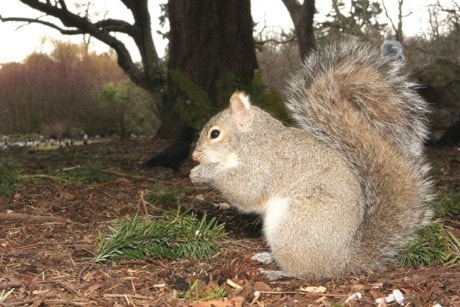They may look cute and furry, but a small alien squirrel species continues to be a very big problem on the south Island.
The eastern grey squirrel – which also comes in black – is listed by the province as an invasive wildlife species, one that Esquimalt resident Judith Morton has battled since 2007. She said the critters have nested in her attic and chewed electrical wires, creating a potentially flammable and dangerous mess that cost her $10,000 to fix.
That doesn’t surprise wildlife biologist Sean Pendergast with the B.C. Ministry of Natural Resource Operations.
His regional office in Nanaimo fields upwards of 100 calls a year from Island residents wanting to know how they can eradicate the squirrels.
“It’s probably second only to bullfrog calls,” he said.
Although the truth of how they came to Greater Victoria is cloudy – one theory says a group of squirrels were transported to Metchosin from eastern Canada in the 1960s as pets – it’s clear their proliferation on the south Island began after they were released into the wild or relocated, Pendergast said.
The grey squirrel overshadows its smaller red cousin, which is native to the Island. As well as chewing into attics, the grey rodents can gut a garden of plant bulbs, strip the bark from rare Garry oak trees and eat their way through songbird populations.
“(Grey squirrels) can cause significant damage,” said Pendergast. “There’s got to be thousands of them on southern Vancouver Island.”
To make matters worse, the bigger and badder cousin to the red squirrel is not a favourite meal among predators. A mass trapping or sterilization campaign could be effective, but would be an expensive and difficult solution to the pervasive problem, Pendergast said.
The critters pose such a nuisance that they have long been on the province’s list of invasive species. Under the B.C. Wildlife Act, people may take matters into their own hands and humanely – and legally – hunt, trap and kill grey squirrels: that means no drowning and no firearms within city limits.
“The reason invasive species may get on (the list) is so that it gives the general public an avenue to deal with the problem on their own without a permit,” Pendergast said.
For those reticent to do the dirty work themselves, a licensed nuisance wildlife trapper can be hired. What residents aren’t allowed to do is trap and relocate the creatures, which is how grey squirrels travelled beyond the Malahat Drive, he said.
Old Island Pest Control is one of several companies in the Capital Region that field squirrel calls on a regular basis.
“We average at least three or four a month,” said Blair Dooley, one of the owners of the company.
According to Dooley, about half of those calls come from Oak Bay.
“The early part of the year is the worst time, especially when they start having their litters,” he said.
After Morton asked for Esquimalt council’s help with her squirrel problem in 2008, she said she has heard nothing from the township and the problem has gotten worse.
“Since then the squirrels are considerably more numerous,” wrote Morton, who declined to be interviewed. “It appears that the squirrels are being fed peanuts, as I find peanuts all over my property, in my planters, and tucked away along the base of my house.”
Esquimalt has no bylaws about feeding wildlife, but that may not be the answer.
“You always have to look at what is the value of a bylaw and what is your capacity to enforce it,” said Esquimalt Mayor Barb Desjardins. “We don’t want to make a bylaw that you can’t enforce, that has no teeth. “It’s better to inform people why they shouldn’t be doing something.”
Vancouver Island University in Nanaimo is undertaking a study on the squirrels and has set up a website to log sightings of the greys.
To report a squirrel sighting or for more information, please visit web.viu.ca/eagillis/squirrels.htm and follow the red links.
emccracken@vicnews.com
Knowing grey from red
• Eastern grey squirrels (pictured) are native to the southeast part of Canada and the eastern U.S., but were introduced in Victoria, Vancouver and Calgary.
• The red squirrel (Tamiasciurus hudsonicus) is the only squirrel native to Vancouver Island. They are grayish-brown to rusty red, and white underneath. They have a pronounced white ring above and below their eyes.
